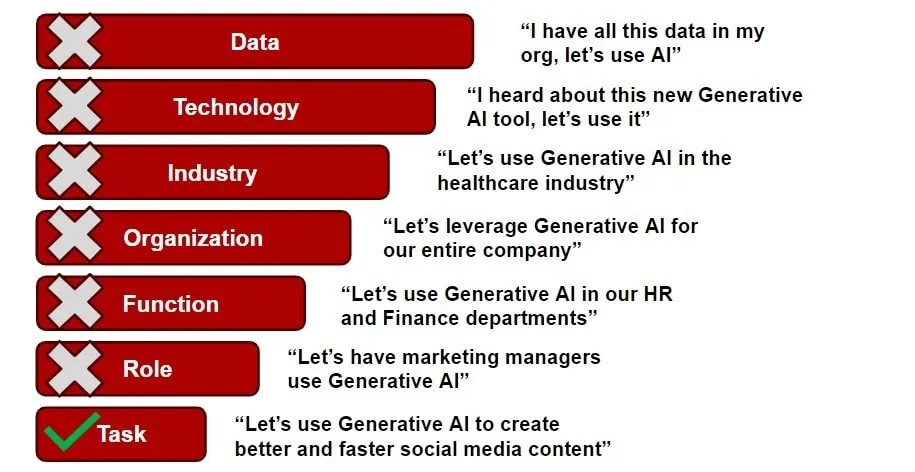
Understanding how to navigate the generative AI space is crucial for any organization looking to harness its potential. To aid in this journey, let’s explore a structured approach to evaluating generative AI use cases, focusing on seven key dimensions: data, technology, industry, organization, function, role, and task. This post aims to simplify the complexities of generative AI and provide a clear path for its practical application.

Dimension 1: Data
When we talk about generative AI in the context of data, we refer to the utilization of organizational data to drive AI initiatives. Imagine a company overflowing with data, unsure of how to leverage it. Generative AI steps in as a solution, transforming this data into actionable insights or innovative products.
Dimension 2: Technology
The technological dimension is all about the tools and platforms that make generative AI possible. This could be a new software or AI tool that has recently entered the market. The key question here is how can these technological advancements be used effectively in a business setting?
Dimension 3: Industry
Each industry presents unique challenges and opportunities for generative AI. For instance, in healthcare, AI might be used to analyze patient data or assist in diagnostic procedures, while in retail, it could be used for personalizing customer experiences. Understanding the industry-specific applications of generative AI is crucial for its successful deployment.
Dimension 4: Organization
This dimension looks at generative AI from an organizational perspective. It’s about integrating AI across the entire company, rather than in isolated pockets. This holistic approach ensures that AI initiatives are aligned with the organization’s overall strategy and goals.
Dimension 5: Function
Generative AI by function refers to its application within specific departments, such as HR or finance. In HR, AI might be used for talent acquisition or employee engagement, while in finance, it could be for risk assessment or fraud detection.
Dimension 6: Role
When we consider the role dimension, we’re looking at how individual job roles can leverage generative AI. For example, marketing managers might use AI for customer segmentation or campaign analysis, enhancing their decision-making and strategic planning.
Dimension 7: Task
The task dimension is perhaps the most tangible and measurable. It involves using generative AI to improve specific tasks, such as content creation for social media. This approach is highly practical as it focuses on enhancing or automating specific actions within a workflow.
Prioritizing Tasks in Generative AI Implementation
The key takeaway from these dimensions is the importance of prioritizing tasks when implementing generative AI. Why tasks? Because they are concrete, measurable, and directly impact daily operations. A task-focused approach ensures that AI solutions have a clear purpose and measurable outcomes. It’s easier to gauge the effectiveness of AI in improving social media content creation than to assess its impact on a broader role like marketing management.
The Interconnectedness of Dimensions
While the task dimension is pivotal, it’s also crucial to understand how these dimensions interconnect. For instance, a task in the marketing department (role) might be influenced by technological advancements (technology) and industry trends (industry). This interconnectedness implies that while focusing on tasks, one should not entirely overlook the other dimensions.
Exploring Other Dimensions
Researching and evaluating generative AI across different dimensions is beneficial. For example, exploring AI trends in healthcare or finance can provide insights into market shifts. Similarly, understanding how AI is being used in HR departments across various companies can spark ideas for your organization. These explorations, though secondary to task-focused implementation, are valuable for strategic planning and keeping abreast of AI advancements.
Solving Problems at the Task Level
Ultimately, the goal of implementing generative AI is to solve problems, and this is most effectively done at the task level. By starting with specific tasks, organizations can address immediate challenges and gradually scale AI solutions to encompass roles, functions, and entire organizational structures.
If you’d like to learn more, check out my “Generative AI for Business Leaders” course on Udemy or my “Generative AI for Busy Business Leaders” book on Amazon.
